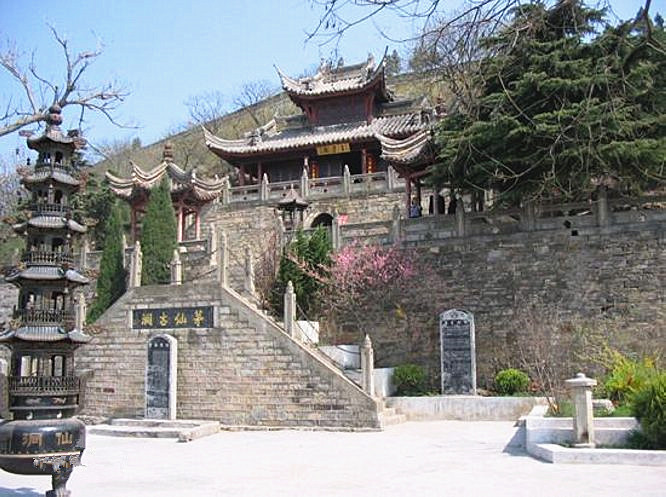
Xilongtan Pool and Sanjiao Palace in Kaiyuan City, Honghe
The Sanjiao Palace (三教殿) is located at the foot of Xilongtan (西龙潭) in the western part of Kaiyuan City (开远市), Yunnan Province (云南省). It is named after the three deities enshrined within: Guanyin (观音), Zhenwu (真武祖师), and Wenchang Dijun (文昌帝君). The building covers an area of 116 square meters.
Historical Background
Originally built during the Ming Dynasty (明代), the palace was first known as Guanyin Temple (观音寺). It was destroyed in 1856 during the turmoil of the Xianfeng Era (咸丰). Reconstruction began between 1898 and 1928 through donations from officials and the public. The architecture follows the slope of Longtan and is aligned along the central axis from west to east. The entire complex includes the main hall, middle hall, lower hall, two wings, and two symmetrical hexagonal pavilions, covering an area of 1,900 square meters.
Architectural Features
The main hall features a single-eave hard hill roof with a wooden beam-frame structure, measuring 13.5 meters in length, 8 meters in width, and 9.6 meters in height. The ceiling is decorated with delicate watercolor paintings of fruits, bamboo, and orchids. The side rooms, built in a two-story wooden structure, measure 10.7 meters long, 6.7 meters wide, and 8.5 meters high. Historically, the north wing housed statues of Mu Guiying (穆桂英) and other deities, symbolizing protection against autumn frosts.
The middle hall originally contained statues of Guanyin (观音), Manjushri (文殊), and Samantabhadra (普贤), but these were destroyed in 1931. Later, it was renamed Caishen Hall (财神殿) after statues of the Earth Mother (地母) and the God of Wealth (财神) were installed. The hexagonal pavilion, constructed in traditional wooden style, stands approximately 9 meters tall.
Recent Renovations
In 1994, community funding supported major renovations, replacing decayed wooden columns with brick ones. By 1997, the roof was redesigned, replacing grey tiles with yellow glazed tiles. In April 2004, additional decorative work was carried out, altering some of the building’s historical features.
Xilongtan Pool
Xilongtan (西龙潭), also known as West Dragon Pool, is located at the foot of Longtan Hill (龙潭坡). It measures over 20 meters in length and 10 meters in width, with a total area exceeding 200 square meters. Surrounded by stone walls, its back wall rises 5 meters high and bears the inscription “水不在深” (“The depth of water is not what matters”) by Wu Xizhong (吴锡忠), a renowned Yunnan calligrapher from the late Qing Dynasty (清代).
Natural Beauty and Cultural Significance
Springs flow from both sides of the pool, providing clear, sweet water year-round, with fish swimming and ancient trees leaning overhead. Locals believe the water is a blessing and often use it for making tea. Historically, this spring irrigated extensive farmland outside the city, making it an important ancient irrigation source.
Historical Poets and Cultural Reflections
During the Ming Dynasty, local poets such as Wang Tingbiao (王庭表) composed poems celebrating the area’s beauty. In his poem Visiting Guanyin Temple: Farewell to Yang Yongxiu (《游观音诗·答杨用修留别》), he wrote:
The peaceful scenery lies in the southern land,
Cranes dance in the spring fields, wandering with guests.
The atmosphere seems to dry a thousand threads of ink,
In carefree ease, one still hears the white clouds sing.
Current Usage
Today, the Sanjiao Palace serves as a multi-deity temple. It houses statues of the Dragon King (龙王), God of Wealth (财神), Earth Mother (地母), and other deities, reflecting the diversity of Chinese religious culture.
How to Get There
From nearby cities such as Kunming (昆明), you can reach Xilongtan Pool and Sanjiao Palace by bus or car. The drive takes approximately 2–3 hours, depending on traffic conditions. Local buses operate frequently from the city center.
Travel Tips
Best Time to Visit: March–April and September–November offer mild weather and minimal rainfall.
Cultural Etiquette: Dress modestly, respect temple customs, and ask for permission before taking photographs.
Local Cuisine: Try local dishes made with fresh ingredients, and enjoy tea brewed with the pure spring water.
Weather Considerations: The area experiences a subtropical plateau monsoon climate, with the rainy season lasting from May to October.

 7 Days GolfingTour
7 Days GolfingTour
 8 Days Group Tour
8 Days Group Tour
 8 Days Yunnan Tour
8 Days Yunnan Tour
 7 Days Shangri La Hiking
7 Days Shangri La Hiking
 11 Days Yunnan Tour
11 Days Yunnan Tour
 6 Days Yuanyang Terraces
6 Days Yuanyang Terraces
 11 Days Yunnan Tour
11 Days Yunnan Tour
 8 Days South Yunnan
8 Days South Yunnan
 7 Days Tea Tour
7 Days Tea Tour
 8 Days Muslim Tour
8 Days Muslim Tour
 12 Days Self-Driving
12 Days Self-Driving
 4 Days Haba Climbing
4 Days Haba Climbing
 Tiger Leaping Gorge
Tiger Leaping Gorge
 Stone Forest
Stone Forest
 Yunnan-Tibet
Yunnan-Tibet
 Hani Rice Terraces
Hani Rice Terraces
 Kunming
Kunming
 Lijiang
Lijiang
 Shangri-la
Shangri-la
 Dali
Dali
 XishuangBanna
XishuangBanna
 Honghe
Honghe
 Kunming
Kunming
 Lijiang
Lijiang
 Shangri-la
Shangri-la
 Yuanyang Rice Terraces
Yuanyang Rice Terraces
 Nujiang
Nujiang
 XishuangBanna
XishuangBanna
 Spring City Golf
Spring City Golf
 Snow Mountain Golf
Snow Mountain Golf
 Stone Mountain Golf
Stone Mountain Golf














